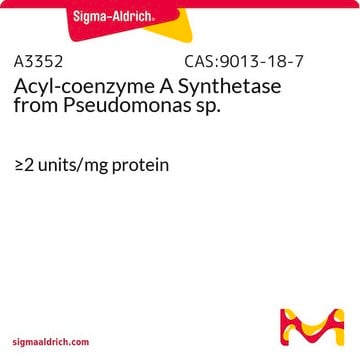A1765
S-Acetyl-coenzyme A synthetase from baker′s yeast (S. cerevisiae)
lyophilized powder, ≥3 units/mg protein
Synonym(s):
Acetate CoA ligase (AMP forming), Acetate thiokinase
Select a Size
$298.00
Available to ship onApril 08, 2025Details
Select a Size
About This Item
$298.00
Available to ship onApril 08, 2025Details
Recommended Products
form
lyophilized powder
Quality Level
specific activity
≥3 units/mg protein
composition
Protein, 10-30% biuret
storage temp.
−20°C
Looking for similar products? Visit Product Comparison Guide
Application
Biochem/physiol Actions
Packaging
Unit Definition
Physical form
signalword
Danger
hcodes
pcodes
Hazard Classifications
Resp. Sens. 1
Storage Class
11 - Combustible Solids
wgk_germany
WGK 1
flash_point_f
Not applicable
flash_point_c
Not applicable
ppe
Eyeshields, Gloves, type N95 (US)
Choose from one of the most recent versions:
Certificates of Analysis (COA)
Don't see the Right Version?
If you require a particular version, you can look up a specific certificate by the Lot or Batch number.
Already Own This Product?
Find documentation for the products that you have recently purchased in the Document Library.
Customers Also Viewed
Articles
Enzyme Reagent Coenzyme A (CoA, CoASH or HSCoA) is the key cofactor in first step of the TCA cycle, responsible for transferring the acetyl group from pyruvate oxidation to oxaloacetate yielding citrate. Available through Sigma-Aldrich online.
Active Filters
Our team of scientists has experience in all areas of research including Life Science, Material Science, Chemical Synthesis, Chromatography, Analytical and many others.
Contact Technical Service









